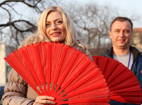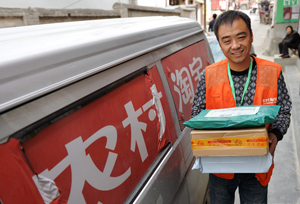News
Novel way to bring the grottoes' treasures to life
Updated: 2016-01-19By Lin Qi ( China Daily )
The discovery of an important cache of Buddhist sutras in Dunhuang, in 1900 had a profound influence on Chinese fine arts in the 20th century.
And since the 1930s, masses of Chinese artists have journeyed to Northwest China's Gansu province to be inspired by the magnificent cave art there.
Among the most well-known of these artists is Zhang Daqian, whose Dunhuang-inspired ink paintings have sold for tens of millions of yuan at auctions.
Even today, artists working in various mediums and using various experimental approaches still see a pilgrimage to Dunhuang as a must.
Crossing Dunhuang, an exhibition at Beijing's Taimiao Ancestral Temple, takes visitors on a journey through the mystic grottoes on the ancient Silk Road.
A juxtaposition of 300 fresco painting copies and contemporary art reflect the spiritual links among artists from different periods.
The exhibition is comparable to Dunhuang: Songs of Living Beings, another show now underway at the Shanghai Himalayas Museum that runs through March.
The display in Beijing opens with the Echo of Civilization exhibition series by Beijing's Central Academy of Fine Arts. Imitations of the cave paintings on show come from the collection of CAFA and the Dunhuang Academy China, the institution that focuses on Dunhuang.
Among the artists whose works are on show is Chang Shuhong (1904-94). He graduated from the prestigious National School of Fine Arts in Paris, but sacrificed his potentially bright career prospects as he chose to protect Dunhuang's art.
Chang arrived at the Mogao Grottoes in 1943 and became the founding member and the first director of the Dunhuang Academy China. Because of his lifelong devotion to Dunhuang's preservation, Chang is hailed as the "guardian of Dunhuang".
Some of the other artists whose works are on display are modern masters who taught at CAFA - Ye Qianyu, Sun Zongwei and Wu Zuoren.
The artists often traveled with their students to Dunhuang to study "the fruits of cultural communication between the East and West some 1,000 years ago", says Fan Jinshi, 78, a former head of Dunhuang Academy China.
Fan worked in Gansu for 53 years. She regularly received groups of CAFA teachers and students who studied cave art in the 1960s.
They spent whole days in the caves making copies of the grotto paintings, she says.
"I'm an archaeologist, so I know very little about fine arts. And though at the time I was impressed by their hard work, I often wondered why artists like them would feel so excited about the caves," Fan says.
"Now after seeing the reproduction, I understand them more deeply. The grottoes show the achievements of ancient Chinese artists of several generations," she adds.
The groups of artists who have visited Dunhuang over the past decades have left several thousands of copies of great accuracy and refinement, according to Hou Liming, director of the fine arts institute affliated to Dunhuang Academy China.
He says these works show the brilliance of Dunhuang's art to the world.
"Through meticulous brushstrokes, they have conducted a dialog of soul and belief with the ancient painters. Their accomplishments help people get to the depth of a civilization of a thousand years ago, and they communicate the persistence and firmness of those who made Dunhuang's art so glorious," he says.
The exhibition gathers the works of leading contemporary artists, such as Xu Bing and Zhan Wang, whose artworks not only reflect their understanding of the ancient Chinese outlook of the world, but they have also borrowed elements of Dunhuang art, including the vibrant colors, to create wearable designs such as costumes.
Fan Di'an, the head of CAFA and the exhibition's curator, says cultural traditions need to inspire creators in different fields today. He believes that the film trilogy, The Lord of the Rings, has set a good example of "fusing legends, myths and philosophies into a blockbuster with the help of special effects."
He hopes that the exhibition can inspire the development of more creative forms to enliven Dunhuang art.
linqi@chinadaily.com.cn


